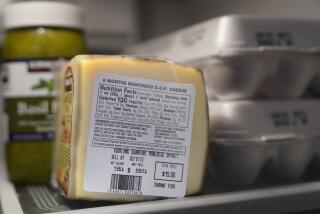What an ‘organic’ food label should mean
Many Americans would like to know more about what they eat, including whether the food they purchase contains genetically modified organisms, or GMOs. That desire has sparked ballot initiatives and bitter fights in states across the country. But what a lot of concerned consumers don’t realize is that there is already a way to ensure that the foods they purchase are free of GMOs.
During the Clinton administration, we were responsible for implementing the Organic Foods Production Act. One of the implementation decisions that had to be made about the law after its passage was whether GMOs could be used in organic food. After receiving nearly 300,000 public comments during the rule making process, we said no. This means that foods certified as organic are also GMO-free.
So why aren’t more consumers aware of this? Because producers of organic food are in effect banned from letting them know.
YEAR IN REVIEW: Kindness in the world of politics? 7 uplifting examples from 2013
Personally, neither of us is opposed to the use of GMOs and believe they can address important food and agricultural needs. The public made clear, however, that it didn’t feel such organisms belonged in food with an “organic” label.
For more than a decade, organic farmers, ranchers and food processors have been subject to rigorous annual inspections to ensure they are in compliance with national organic standards. The scrutiny is carried out by agents accredited by a division of the Department of Agriculture. But responsibility for overseeing food labeling lies with another part of the USDA, along with the Food and Drug Administration, and they continue to reject petitions by organic food producers who want to label their products as “GMO-free” or “produced without use of GMOs.”
Absent such labeling, we continue to have expensive election fights. Last month, for example, a ballot initiative in Washington state sought to mandate labeling of food produced using genetic engineering. It was narrowly defeated, but only after months of debate and $30 million of spending by those wishing to sway voters one way or the other.
YEAR IN REVIEW: Paul Walker and six other inspirational people who died too soon
Connecticut and Maine have both passed laws requiring labeling of foods containing genetically modified organisms, although the laws won’t go into effect until neighboring states pass similar labeling laws. All told, this year more than half the states considered some sort of GMO labeling measure. Leaders on both sides of this food fight have vowed to carry on.
We believe that much of the energy around GMO food labeling would dissipate if the federal government honored the original deal we struck on organic food and allowed producers to label their products as GMO-free.
Resistance by the USDA seems especially inconsistent, given that one branch of the agency enforces the organic rule, including the GMO prohibition, while down the hall, another rejects labels submitted by organic companies.
For many years, the agency said this was because it had no way to verify such claims. Thanks to Secretary Tom Vilsack, who issued a memorandum this year directing all USDA agencies to recognize the department’s organic standards, the verification objections are dying down.
But now there is debate over what a label should say. The FDA published draft guidance on voluntary GMO labeling in 2001 but has never completed its document, leaving the organic industry in limbo. Recently the USDA has indicated a willingness to consider “non-GE” as a potential label claim. That is the term preferred by the biotechnology industry, but it is unfamiliar to the vast majority of consumers.
Another impediment to labeling cited by regulators is the fact that there are trace amounts of GMOs in the environment, which makes producing an absolutely pure GMO-free food product challenging. But this is reason for industry and government to work harder to find ways to prevent cross-contamination of crops, not sufficient justification to reject GMO-free labels.
There is broad consensus that a threshold for an allowable — and unavoidable — amount of GMOs in organic and other non-GMO produced food is a necessary accommodation. The U.S.-based Non-GMO Project and European countries set this threshold at 0.9%. The USDA and FDA should adopt this threshold and move forward expeditiously.
An organic GMO-free label would also help consumers distinguish organic food from food labeled as “natural.” Natural foods are eroding the organic market space, despite the lack of any clear-cut standard for what the term means or federal oversight. Allowing organic products to be labeled GMO-free would provide a clear distinction between the terms “organic” and “natural.”
Mandatory GMO labeling of all food will continue to arouse passions on both sides of the issue. Though it may not satisfy all GMO-labeling advocates nor be welcomed by all leaders in the biotechnology industry, allowing a GMO-free organic label provides more choice in the marketplace and responds to the demands of millions of American consumers in a practical and common sense way.
Dan Glickman, a former congressman, was secretary of Agriculture from 1995 to 2001. He is executive director of the Aspen Institute Congressional Program. Kathleen Merrigan, now a consultant, was deputy secretary of Agriculture from 2009 to 2013. Among her clients is a large organic-farming cooperative.
More to Read
Sign up for Essential California
The most important California stories and recommendations in your inbox every morning.
You may occasionally receive promotional content from the Los Angeles Times.










